|
|
|
Sort Order |
|
|
|
Items / Page
|
|
|
|
|
|
|
| Srl | Item |
| 1 |
ID:
157082
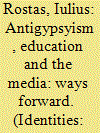

|
|
|
|
|
| Summary/Abstract |
This article is a self-reflection of my work over a decade of challenging school segregation of Roma across Europe. I look at how segregation has been framed and how communication around equality in education with the public took place. The education system is an important pillar in producing and reproducing antigypsyism in society. I see school segregation as an important mechanism that perpetuates antigypsyism. I explore ways to attract support for equality measures in education. One important strategy is to engage with media in transmitting messages to an audience that was usually not the target of inclusive discourses that promote diversity and equality as societal values.
|
|
|
|
|
|
|
|
|
|
|
|
|
|
|
|
| 2 |
ID:
157075
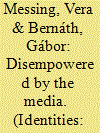

|
|
|
|
|
| Summary/Abstract |
Roma communities have experienced widespread historical exclusion in most European countries. The media can be a powerful instrument of a group’s inclusion into the mental map of a society, or, on the contrary, it can contribute to the group’s exclusion and disempowerment. This article builds on a series of content and discursive analyses of the news media’s coverage of Hungarian Roma communities since 1993, interviews with stakeholders and focus group discussions in Roma communities. It scrutinises media reporting about Roma and argues that, in general, the scope and the agenda of Roma’s portrayal coincide with mainstream society’s stereotypes about the group. The article will additionally look at the media’s disempowering role from two perspectives: on the one hand, the extent to which Roma have access to influencing media content, and on the other hand, it will consider the role of minority communities in challenging stereotypical images.
|
|
|
|
|
|
|
|
|
|
|
|
|
|
|
|
| 3 |
ID:
157078
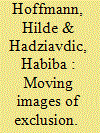

|
|
|
|
|
| Summary/Abstract |
This paper analyses the most prominent tropes in the earliest and most recent filmic representations of Roma. Stereotypical images of Roma abound in many fictional features as well as documentaries, from the representation of Roma as eternal nomads to racially prejudiced depictions of Roma women and the alleged innateness of music to Roma. Because images and modes of representation change over time, the paper juxtaposes the earliest portrayals of Roma with those produced in the last 15 years. The analysis particularly centres on two dominant reoccurring tropes: types of spaces typically occupied by Roma in film, that is the lack of a place or so-called placeless-ness of Roma; the gendered other, or the Roma woman and the culturally and ethnically othered Roma musician. Ultimately, by analysing how these tropes have persisted in varying forms over 100 years, this work points to the filmic imagery that perpetuates antiziganism, but also how the same has changed over the years to offer possible counter-narratives.
|
|
|
|
|
|
|
|
|
|
|
|
|
|
|
|
| 4 |
ID:
157077
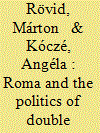

|
|
|
|
|
| Summary/Abstract |
The article analyses the politics of ‘double discourse’ in relation to Roma that has evolved in contemporary neoliberal Europe. On the one hand, the double discourse promotes the integration, rights and equal opportunities of Roma, on the other, it denies recognition of, and ways to address, enduring structural violence and rising social insecurity. The article argues that the politics of ‘double discourse’, as a neoliberal approach towards Roma, is structured by two contradictory discourses that speak to different audiences, using duplicitous approaches to create anti-Roma consensus and maintain the critical difference and subordinated position of the racialised Romani populations in Europe. By studying the representation of Roma in the cases of so-called 'child theft' in Greece and Ireland, and in the recent ‘refugee crisis’, the paper identifies and discusses three dimensions of contemporary neoliberal double discourse: racialised de-Europeanisation, neoliberal undeservingness and (dis)articulation of citizenship.
|
|
|
|
|
|
|
|
|
|
|
|
|
|
|
|
| 5 |
ID:
157081
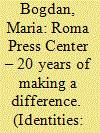

|
|
|
|
|
| Summary/Abstract |
The Roma Press Center (RPC) is the first Roma news agency in Hungary with the goal of reducing prejudice against the Roma. Their profile has been changed throughout the years, since the technological developments of the media and the political and economic changes of the country challenged their way of effectiveness. Until recently, the RPC was always about reacting to the negative stories about the Roma and balancing this image in the media. In the last 3 years, RPC changed its attitude by becoming a proactive media organisation which directly participates in shaping the public discourse about the Roma with their work. The interview with the two decisive characters of the RPC tells about this process.
|
|
|
|
|
|
|
|
|
|
|
|
|
|
|
|
| 6 |
ID:
157074
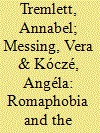

|
|
|
|
|
| Summary/Abstract |
This special issue of Identities, entitled ‘Romaphobia and the media’, examines entrenched and ongoing media coverage of Roma, Gypsy and Traveller people across Europe. The focus is on how the media problematises the Roma, how it constructs a ‘conceptual map’ about Roma people and what this tells us about the societies we live in. This special issue includes five academic articles all examining the constructions and stereotypes used in the media in various formats and European countries. After these academic articles, this special issue then deviates from the normal journal structure by including three commentary pieces from professionals from varying Roma backgrounds to give their views and experiences on how they tackle Romaphobia and the media. The inclusion of these commentary pieces are very powerful in offering a perspective of active interventions and resistance that we should not forget amidst the depressing continued circulation of racialised stereotypes.
|
|
|
|
|
|
|
|
|
|
|
|
|
|
|
|
| 7 |
ID:
157080
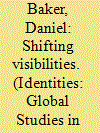

|
|
|
|
|
| Summary/Abstract |
This paper is a personal reflection by a Roma artist upon the mutual influence of Roma social relations and Roma visual culture. Strategies of art making are considered via analyses of contemporary Roma art works. It is suggested that historic marginalisation and continuing discrimination have determined the contingent nature of the Roma aesthetic resulting in keen facilities for adaptation and obscured visibility. Roma artefacts are shown to employ these resistant characteristics of Roma visuality to convey social, cultural, artistic and political agency via visual and performative means. The conclusion calls for a reconceptualisation of Roma visibilities so that we as Roma might forge new political unities and new forms of politics to more effectively challenge embedded Romaphobia.
|
|
|
|
|
|
|
|
|
|
|
|
|
|
|
|
| 8 |
ID:
157076
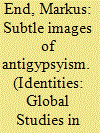

|
|
|
|
|
| Summary/Abstract |
This paper analyses the powerful stereotypical media discourse that shapes and reproduces a certain racialised and prejudiced perception of people identified as “Roma” in Germany. Using a close analysis of a single picture – appearing as harmless at first glance – and through the reconstruction of its various interpretational contexts and semantics the paper identifies mechanisms used in stereotypical media coverage of “Roma”. This qualitative analysis draws on media analysis of antigypsyism as well as on research of photographic construction of the “gypsy” in order to analyse the contemporary visual regime of “Roma” in Germany. As it portrays “the Roma” as a fundamentally different and socially deviant group, this visual stereotyping is shown to be an integral element of the persistent antigypsyist ideology, deeply embedded in German society.
|
|
|
|
|
|
|
|
|
|
|
|
|
|
|
|
| 9 |
ID:
157079


|
|
|
|
|
| Summary/Abstract |
The visual image of Roma people in the media is mired in racialised notions of ‘the other’. Whilst we know what Roma stereotypes look like, there is little clarity as to how a ‘non-stereotypical’ image might be constructed. In order to examine the non-stereotypical, two sources of images are analysed: (1) entrants from an anti-stereotype Roma photography competition and (2) self-representations produced by Roma participants during ethnographic research. The findings show that if ‘Roma’ is foregrounded as the subject, even a non-stereotypical approach can reproduce ‘difference’ (from a supposed ‘norm’). ‘Roma’ is thus, at the moment, still strongly linked to a notion of ethnicity that is seen as different and racialised. However, when ethnicity is not emphasised, but rather self-representations and the ‘everyday’, such orthodoxies are challenged. These sources provide a unique opportunity to create a deeper understanding of ‘non-stereotypical’ images in order to challenge misrepresentations and racism.
|
|
|
|
|
|
|
|
|
|
|
|
|
|
|
|
|
|
|
|
|